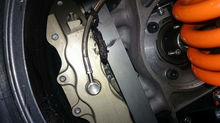Steering Systems
- Alex Harrington
- Nov 19, 2015
- 3 min read
Steering systems were the topic of this week’s lesson. The main focus was on the different components of the system and the variation across different systems.
The rack and pinion is the most commonly used system in road cars and race cars, this system can be power assisted meaning that we have either hydraulics or an electric motor assisting the force exerted on the rack to turn the wheels. In an electrical power steering system we have an electric motor that assists the driver and it allows us to have a physical connection from the driver to the rack, with a hydraulically assisted system we use a liquid to pressurise a certain side of the rack to push the rack in a direction. With the electrical system we can control everything the system does through a computer and can limit how much the assistance actually does for the system (for regulation purposes) but with the hydraulic system we cannot have as much control and once it has been fitted we cannot change a lot about the system also this is prone to leaks and if the vehicle is involved in an accident the whole rack will probably need to be replaced because it would be very awkward to fix.
With mostly off road vehicles such as Land Rovers we use a steering box system, we can have different types of steering box such as recirculating ball, worm and sector, worm and roller and cam and lever. The function of all of these systems is to convert the rotational movement of the steering wheel and column to linear motion to turn the wheels. The system is the same as the rack and pinion system up to the steering box, this then moves the pitman arm and this in turn moves the track rod and the wheels. In the case of the Land Rover and some other off road vehicles we use a steering damper, this is there to control unwanted movement in the wheels, this is basically because the vehicle is so big and if it was to hit a large bump or if it is traveling fast then we don’t want any sudden shocks to jerk the wheels and upset the balance and structure of the car. it is mounted to the chassis and one end to the track rod.
We can also find a system called cam and peg, this is found mostly on Quad bikes and golf buggy, it is a very simple system and is used on quad bikes mostly because on there we have handle bars not a steering wheel. It operates simply by a worm gear rotating and a cam with a peg resting in the gear follows the groove in the gear and moves the shaft connected and thus turns the wheels. It is not dissimilar to the cam and lever steering box but is a slight variation of the design.
We can change the ratio of a steering rack and pinion quite easily by changing the sizes of the pinion gear used, this changes how many full revolutions of the steering wheel we need to go from full lock to the opposite lock, it is better in racing and motorsport in general to have less turns lock to lock so the driver has to do less work in the car and can be more precise about the steering input. It is good for road cars to have quite a few turns lock to lock because we need to manoeuvre road cars more accurately at low speeds, such as in a car park.















Comments